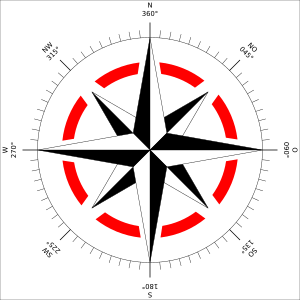Hello ladies and gents this is the Viking telling you that today we are talking about
COMPASS ROSE

A compass rose, sometimes called a windrose, or Rose of the Winds, is a figure on a compass, map, nautical chart, or monument used to display the orientation of the cardinal directions: North, East, South, and West—and their intermediate points. It is also the term for the graduated markings found on the traditional magnetic compass. Today, the idea of a compass rose is found on, or featured in, almost all navigation systems, including nautical charts, non-directional beacons (NDB), VHF omnidirectional range (VOR) systems, global-positioning systems (GPS), and similar equipment.
The modern compass rose has eight principal winds. Listed clockwise, these are:
Compass point Abbr. Heading Traditional wind
- North N 0° Tramontane
- North-East NE 45° (45°×1) Greco or Grecale
- East E 90° (45°×2) Levante
- South-East SE 135° (45°×3) Sirocco
- South S 180° (45°×4) Ostro or Mezzogiorno
- South-West SW 225° (45°×5) Libeccio or Garbino
- West W 270° (45°×6) Ponente
- North-West NW 315° (45°×7) Maestro or Mistral
Although modern compasses use the names of the eight principal directions (N, NE, E, SE, etc.), older compasses use the traditional Italianate wind names of Medieval origin (Tramontana, Greco, Levante, etc.)
- 4-point compass roses use only the four "basic winds" or "cardinal directions" (North, East, South, West), with angles of difference at 90°.
- 8-point compass roses us the eight principal winds—that is, the four cardinal directions (N, E, S, W) plus the four "intercardinal" or "ordinal directions" (NE, SE, SW, NW), at angles of difference of 45°.
- 16-point compass roses are constructed by bisecting the angles of the principal winds to come up with intermediate compass points, known as half-winds, at angles of difference of 221⁄2°. The names of the half-winds are simply combinations of the principal winds to either side, principal then ordinal. E.g. North-northeast (NNE), East-northeast (ENE), etc.
- 32-point compass roses are constructed by bisecting these angles, and coming up with quarter-winds at 111⁄4° angles of difference. Quarter-wind names are constructed with the names "X by Y", which can be read as "one quarter wind from X toward Y", where X is one of the eight principal winds and Y is one of the two adjacent cardinal directions. E.g. North-by-east (NbE) is one quarter wind from North towards East, Northeast-by-north (NEbN) is one quarter wind from Northeast toward North. Naming all 32 points on the rose is called "boxing the compass".
The 32-point rose has the uncomfortable number of 111⁄4° between points, but is easily found by halving divisions and may have been easier for those not using a 360° circle. Using gradians, of which there are 400 in a circle, the sixteen-point rose will have twenty-five gradians per point.
And as always have a chilled day from the Viking
Comments
Post a Comment